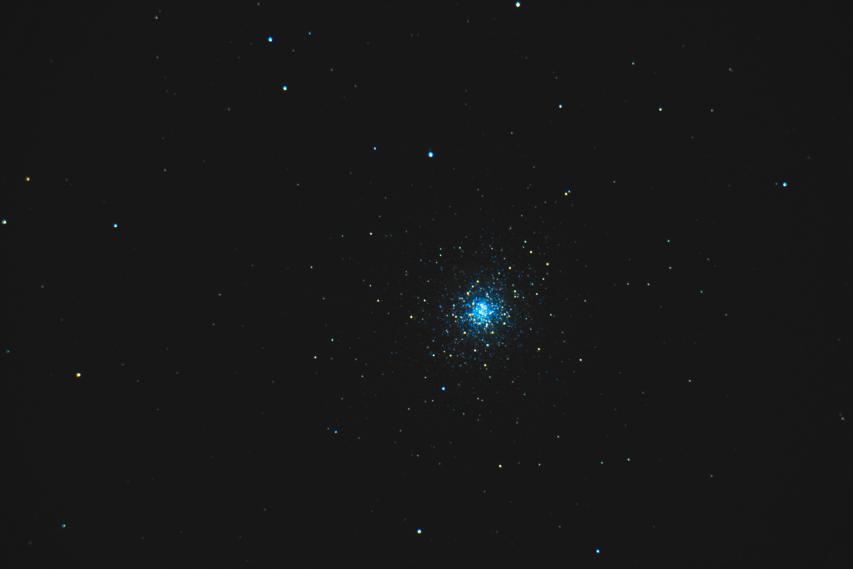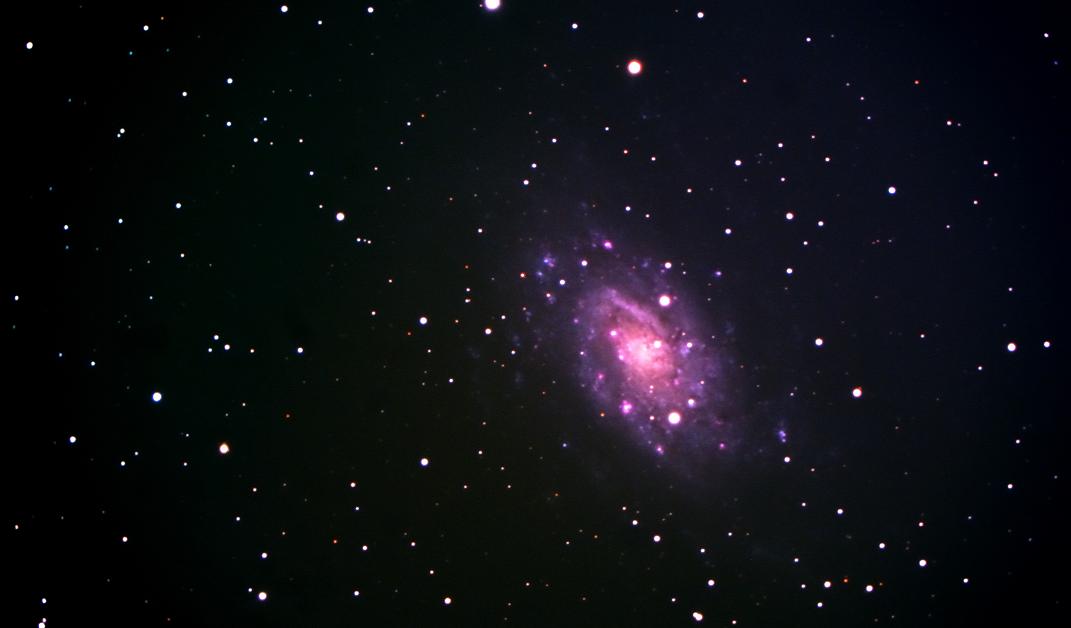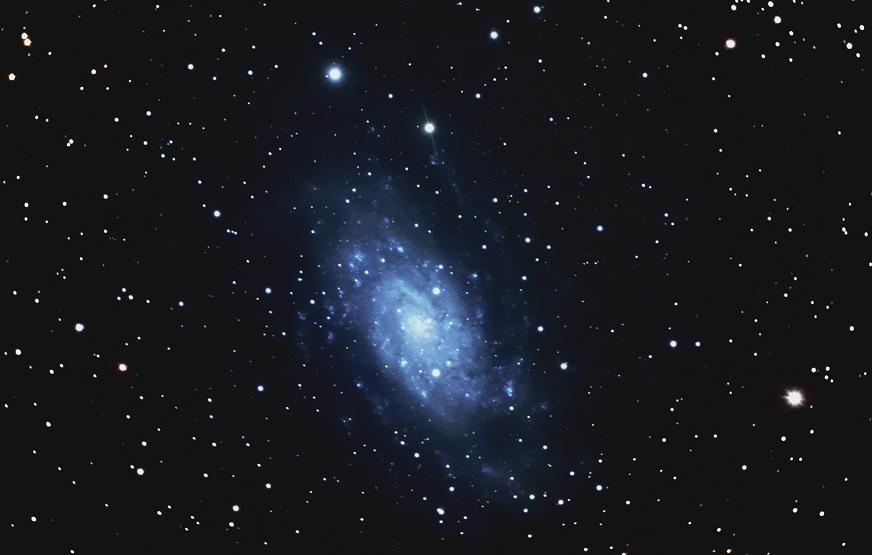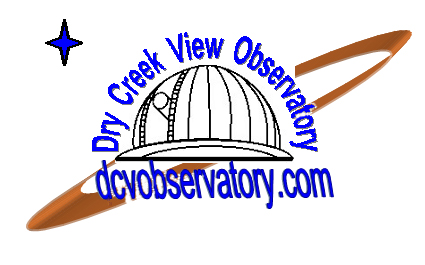Go
to Astronomical Viewing Blog Archive
Go To the Beginning Post
.
December 26, 2013
Last night, I decided to spend
Christmas taking pictures and I ran into a problem that I had
not encountered before. It was very cold around 5 degrees F. The
warm room was warm, but the scope room was undoubtedly cold. I
took a picture of NGC 4236 a Galaxy near Bodes Galaxy M81. The
Galaxy is fairly large, but only has an apparent magnitude of
around 10. The problem I had was frosting on the corrector plate
of my scope. The image turned out OK, but not as good as I would
have preferred. I will try again soon with a dew shield on the
scope to get a clear picture. At the end of the session, I took
a picture of NGC 1977 the Running Man.
November 9, 2013
I finally got a chance to enter
my observatory and do some photography. The summer has been really
busy with my "Day Job" and the weather has not been
cooperating. Now that the clocks are back at "Standard Time"
the skies are dark by 6:00 PM and I can take pictures and be back
in the house by 9:00 PM. Since I need to be at my "Day Job"
by 6:00 AM, I can now do some photography and viewing during week
nights. I was very limited during the summer because it did not
get dark until around 9:30 PM. That only left the weekends to
do viewing and as luck would have it, when it was clear, it was
a full moon. Such is the life of an amateur astronomer.
Last night, I took a few pictures
of the crescent moon, and also one of M 92. Even though the moon
was up in a crescent, M92 which has a magnitude of 6.5 was easily
visible in the scope and gave a good target. My Camera Remote
was not available, so I could only take a maximum duration of
30 second shots. I took 10 pictures and stacked them with an ISO
of 1600. I would have preferred to use a lower ISO of around 400-800,
but I would need my remote to take 2 minutes shots. Since I haven't
taken pictures since February, I was happy to just be using the
camera again. The photo I took is below.
 M 92 Shot with the Nikon D3
M 92 same as above only cropped
August 8, 2013
Tonight was one of the clearest,
darkest, and calmest night for viewing the skies. It was perfect
for viewing and would have been even better for taking pictures.
The Milky Way was very prominent and Andromeda could be seen with
the naked eye. My nephew Ken Richards from South Carolina came
and was visiting with us and we did a tour of the Universe. We
were able to see the following and could have seen many more but
we had to get up early then next morning.
Planets: Saturn,
Venus, Neptune, Pluto
Globular Clusters:
M 13 and M 4
Nebulas: M 8
Lagoon, M 20 Trifid, M 57 Ring, M 17 Swan/Omega, NGC 6826 Blinking
Planetary, NGC 7662 Blue Snowball.
Galaxies: M 31
Andromeda, M 33 Triangulum, M 81 and M 82 Bode's, M 101 Pinwheel
and M 51 Whirlpool.
It was nights like this that I
am glad I had the Observatory with the Scope permanently mounted
and aligned. The scope performed flawlessly slewing from one object
to another with great precision. When visitors are viewing, it
is nice to have a scope with computer capability that allows for
constant viewing instead of constantly hunting for objects.
August 3, 2013
It has been a while since I last
was able to look at the heavens. We have had an odd summer here.
It seems that when the skies are clear, it is a full moon. I have
not been able to take pictures because my camera is off being
cleaned. Last week on July 23, we had a huge storm pass over our
town. 0.76 inches of rain fell within 30 minutes. I know that
is not much for those living in the Hurricane belt, but we live
in a desert, and that is allot of rain for us. Since we had the
forest fire last year, flooding out of our mountains is of great
concern. The overflow creek was full and debris from the canyons
plugged off the 10 foot diameter culvert leading to my home. The
water actually washed over the road. Luckily no homes were flooded
in our small community. Water seeped into my scope room as the
flashing between the Scope Room and the warm room was not calked
properly. Very little damage occurred and I have corrected the
problem.
Enough about the weather. Tonight,
it is dark out, but there is still clouds moving into and out
of the area. I was able to look at Venus, Saturn, M13 and Andromeda.
The high clouds prohibited looking at other deep sky objects.
Since the viewing conditions were poor, I decided to do my summer
re-calibration of the scope. I did an All-Star Polar alignment,
and found that the scope was remarkably well aligned. I guess
since the scope is permanently mounted this was not surprising.
I then did a Two Star Alignment and then 4 calibrations stars.
The scope performed as designed and the alignment was a success.
When I slewed to Saturn and M 13 the objects were in the eyepiece
and very little adjustment was required to center the objects.
It was fun to get back in the scope room and do some viewing even
though the conditions were not optimal.
June 21, 2013
The Supermoon is rising over the
eastern mountains and it is completely washing out any hope of
seeing galaxies or even picture taking. The moon is the closest
to the earth in its orbit (221,000 miles, typically 238,000 miles)
and it is nearly full. That is way it is called a Supermoon. Even
with the poor seeing conditions, three people came over to see
the Moon, Saturn and anything else that is visible. They were
Scott Robison, his wife Mary Lou and Gary Robison. To my surprise,
we were able to see M 13 and also M 57. It was a fun night.
June 18, 2013
My nephew Carl Richards and his
wife Tiona came to visit today and they wanted to see the observatory.
The weather is great and the skies are clear, but seeing conditions
are poor due to the developing full moon. We were able to see
Saturn, M 13, and of course the moon. As the moon was not completely
full, along the terminator, we were able to see some very good
craters.
June 5, 2013
Tonight was one of the best nights
to view that has occurred this spring. It was clear with no wind
and perfect viewing conditions. Tonight a local youth group from
the Oak City First Ward consisting of 12 young women and their
leaders came to see the Observatory. They wanted to get an education
on "Basic" direction finding using the stars. I taught
them about the meridian, and the ecliptic. Using a green laser,
I pointed out the "Big Dipper" and taught them how to
find the north star. In the ecliptic, I was able to show them
the constellations of the "Zodiac". The ones I pointed
out were Gemini, Cancer, Leo, Virgo, and Libra. I also showed
them other constellations such as Scorpius, Bootes and the Corona
Borealis. Then I took them inside and showed them Saturn and M13.
All in all, it was a fun night.
May 30, 2013
I finely got a chance to try out
my new D5200 camera after the "Light Leak" was fixed.
I chose as my target NGC 2403 as I had taken this shot before
with the D3 camera. I wanted to see the difference between an
IR modified camera and a non modified camera. I was only able
to take and stack 5 pictures due to time constraints. The results
are below and notice the color differences:
 
The picture on the left is the
Nikon D5200 modified with the IR filter removed shot was ISO 800
5 minutes at f/7.1. The picture on the right was the Nikon D3
at ISO 5000 4.5 minutes. The galaxy is not as detailed in the
left image as it was shot at ISO 800 and only 30 seconds longer
in exposure time. To make things equal, I would need to shoot
the image on the left for 28 minutes at ISO 800. I will try and
kick up the ISO to around 2500 and then the exposure would be
9 minutes. This was a quick test. I wanted to see the color difference
with a modified camera and a non modified camera.
As for the light leak on the D5200,
it is still there. It showed up on the image above, but I cropped
it out. The camera will again be sent back to see if it can be
fixed.
May 25, 2013
Tonight the Finlinson Family came
over to see the Observatory. It was not a very good night for
viewing, as the moon was completely full and the skies were partly
cloudy. Jon Finlinson, Andre Finlinson, Brook Finlinson and Isaac
Finlinson were able to see at least the Moon, and Saturn. I believe
Isaac is only about 8 years old, and has a great knowledge for
his age about astronomy. He knew the major moons of Saturn and
the major craters on the moon. It was a fun night, but not much
for viewing. I invited them over again when we have clear dark
skies.
April 4, 2013
Tonight was not a good night for
viewing, but I was able to give a tour of my observatory to Dr.
J Moody of Brigham Young University and Dr. Cindy Furse of the
University of Utah. Dr. Moody was very instrumental in my decision
to purchase the largest aperture scope that I could afford. It
was a fun night.
April 2, 2013
It was a gorgeous clear night at
the Dry Creek View Observatory. I was excited because I finally
got a chance to use my new modified D5200. Because I need to leave
for work at 5:30 AM tomorrow, I could not stay up late. I did
take one shot of the Orion Nebula.
M42 Shot with the Nikon D5200.
The above image was a single exposure
shot at f/7.1 and 400 ISO for 4 minutes. There was no color adjustment
to the photo only the true color that was seen by the camera.
Notice the deep reds which I can now capture because of the modification
to this camera.
March 20, 2013
Today I broke down and purchased
another camera for my astrophotography addiction. I purchased
a modified Nikon D5200 which has been modified to allow all of
the infrared and color spectrum into the camera. I still have
the Nikon D3 and am not dissatisfied with that camera. On the
contrary, I will still use that camera as it has a full 35 mm
frame and much better signal to noise at higher ISO. The reason
I purchase the D5200 is that I want to someday purchase a "Hyperstar
Lens". This camera is ideally suited for the Hyperstar system
and is much lighter as it will be mounted on the end of the corrector
plate. I am expecting the camera either on Friday March 22 or
Monday March 25. When I receive it, I will take a picture of it
and do more explanation of its capabilities in the Equipment section.
March 12, 2013
Tonight was a fun night. Several
young men ages 16-18 from our Church Ward came over to see the
observatory. When the evening started, the only object in the
sky that could be seen was Jupiter because of high wispy clouds.
Then the knock came on the Warm Room door. Eight young men came
in and wanted to see the heavens. My Clear Sky Chart showed clear
skies so I described how I did photography to buy some time. Then
the skies cleared. It was a beautiful night. We were able to see
Jupiter and its moons, and the Orion Nebula. Because the sky was
so clear, the young men could see 5 of the Core Trapezium stars
(Stars A,B,C,D and E) in the nebula. Since it was such a large
group, these are the only objects we looked at. After they left,
I took the challenge of trying to determine if I could see the
"F" star. Since the conditions were excellent, I let
my eyes adjust and I could make out all 6 stars in the Core of
Orion's Nebula. It was an extremely clear night for viewing.
March 9, 2013
I thought this picture was a fitting
tribute to my mother who passed away on February 27. It is a dance
of Mizar and Alcor. It reminds me of the reunion in Heaven of
my dad Roy Smith who passed away in 1994 and my mother Donnavieve
who passed away in 2013.
In Memory
of Roy and Donnavieve
Before I took the picture above,
I tried to locate Comet C/2011 L4 (Panstarrs) and I was successful.
Since the comet is very near the sun, thus not very high in
the sky, it was still dusk. I located the comet just south of
the ecliptic where the sun set. Since there was still sky glow
from the sun, the comet appeared as a yellow blob. I could not
detect the tail. I will try and get a picture when it is higher
in the sky.
For the past few weeks, I have
not been able to do any imaging or viewing from the Observatory.
I have been spending my free time with my mother who would
have been 90 years old in July. She passed away peacefully
due to incident of age today. She lived a good life and taught
me values that I will cherish the rest of my life. She and
my dad are the ones who peaked my interest in astronomy when
I was only 12 years old. Within the next few weeks, I am planning
on taking a picture of some stars and dedicating it to my
dad and my mom. I will miss her smile, and her wisdom. I love
you Mom.
Friday February 1, I stayed up
and took advantage of clear skies, and temperatures above 0
F. During the cold weather especially in the Scope Room, I put
an Electric Blanket around the telescope mount and turn it on
about 3 hours before I begin observing. This warms up the motors
and worm gears in the EQ Mount. With the Mount warm, I remove
the blanket and prepare for imaging or viewing. Since it has
been really cold, most of my efforts have been in imaging. That
way I can stay in the "Warm Room".
On February 1, my target was
M1 the "Crab Nebula" in the Constellation Taurus.
I took 16 pictures at a duration of 4 minutes each. The interesting
thing about this photo session, is that it was my first time
taking photos when the Scope crosses the Meridian. When this
happens, with an Equatorial Mount, the scope changes sides or
flips from imaging on the east side of the meridian to imaging
the same object on the west side of the meridian. The image
is then rotated 180 degrees. This makes it hard for the stacking
software to align the photos for stacking. I'm sure there is
an easier way to rotate the images for stacking, possibly even
in the stacking software, but I just flipped the four upside
down images in my processing software and then stacked them.
I think it turned out well. The Image was post processed on
February 2, and the final image is shown below and a larger
version is in my Gallery.
Here at the Dry Creek View Observatory,
we have had 3 weeks of sub-zero Fahrenheit temperatures. So
I have decided to practice my processing skills. I have redone
two of the photos in the Gallery. The first was the Galaxy M
52. In the post processing, I changed the way the program renders
noise reduction, and I also boosted the colors. In the second
picture, NGC 2403 all I did was change the noise reduction.
I feel the pictures are much better now. The noise reduction
change was due to a setting which renders a smoother reduction.
The Process is slower, but I believe it makes a much better
picture. The M 52 shot of the Whirlpool Galaxy was one of my
first attempts at a Galaxy. It is not stacked, and is a single
shot. The processing software (Nikon Capture NX2) did a good
job of noise reduction, but I want to try the same shot multiple
times and do some stacking. I believe I can improve it even
further. When it warms up and the moon is gone, I will give
it a try.
The time of this post is January
5, but it actually started on January 4 and went to 2:00 AM
on the 5th. It was the first clear night that we have had since
Mid December and the first since the moon is dark in over a
month. That being said, it was extremely cold. The temperature
in the Scope Room was -9 degrees Fahrenheit. The warm room even
struggled to keep up as it was only 65 degrees. I'm not complaining,
as I did get a chance to image. However I do prefer 72 degrees
inside (he he). I was worried about the scope motors in the
extreme cold, but I did keep them warm prior to the imaging
session by using a heating pad around the mount. Everything
worked fine. Now for the fun stuff. I selected my target for
the night as M74 a spiral galaxy in the constellation Pisces.
It has a magnitude of about 9.2. The photograph I took is shown
below. A larger picture can be seen in the Gallery.
M74 Spiral galaxy in Pisces
Today I installed a Hand Controller
extension cable in the Observatory. The extension works great,
and I can now control the scope from the comfort of the Warm
Room. Especially when the temperature in the Scope Room is -7
degrees Fahrenheit. With the camera in "Live View"
mode, I can center the scope on the image target by using the
"Precise Go To function of the controller. I can precisely
center the "Go To Star" on the computer monitor and
then press enter on the Controller. The reason for the extension,
is that in cold weather, the display on the controller is very
sluggish. With the controller in the Warm Room, that problem
is not existent. I have used NexRemote Software from Celestron
in the past, and it works well, but the problem is that when
using this software I have a conflict when simultaneously connecting
the scope to Stellarium. With the extension, there is no conflict.
A picture of the Hand Controller with the extension cable can
be viewed in the "Equipment Section".
|

